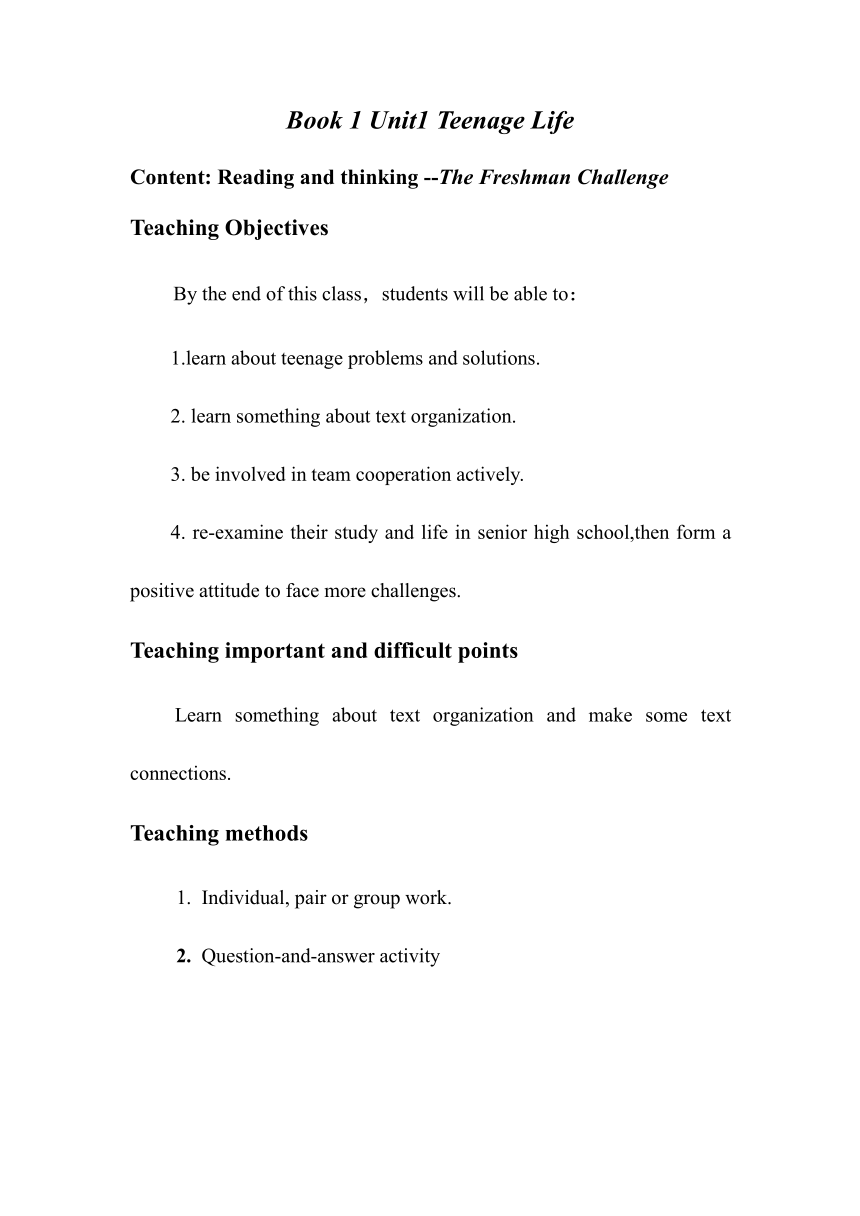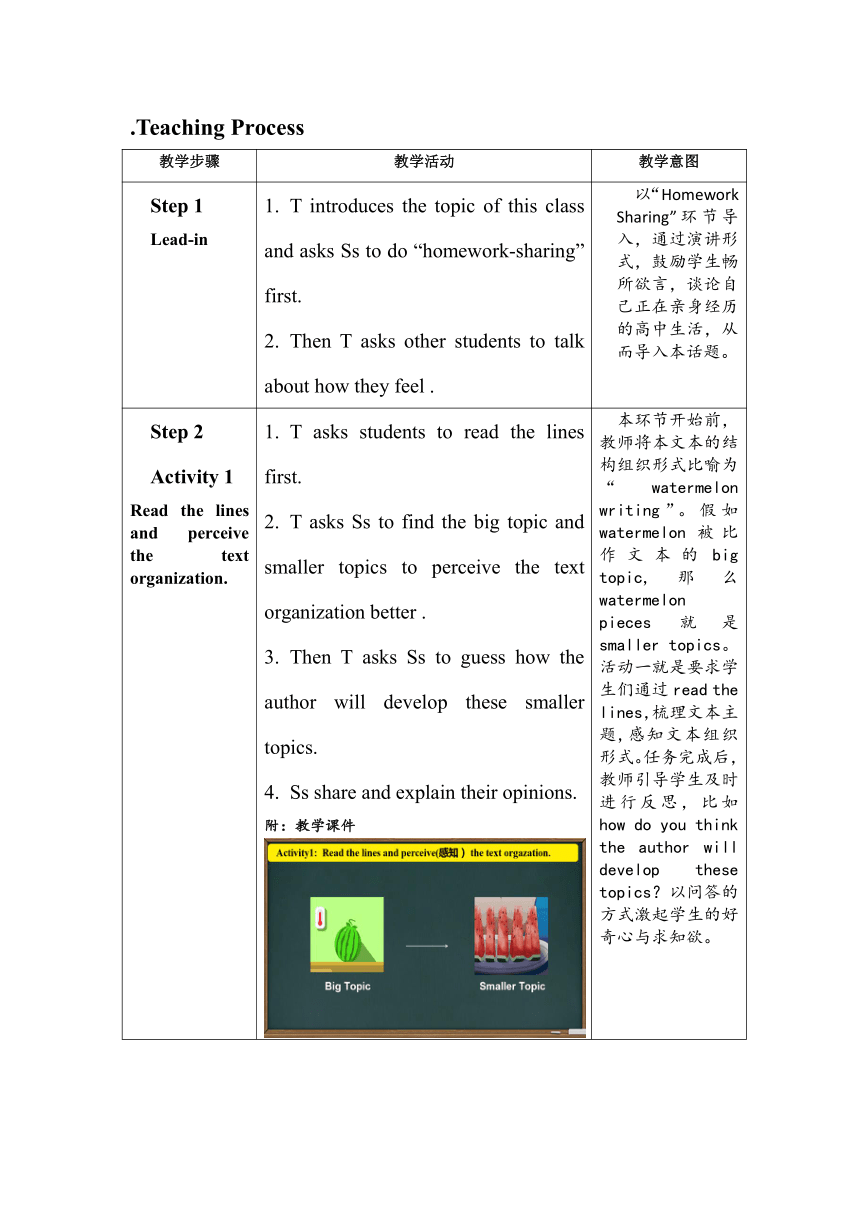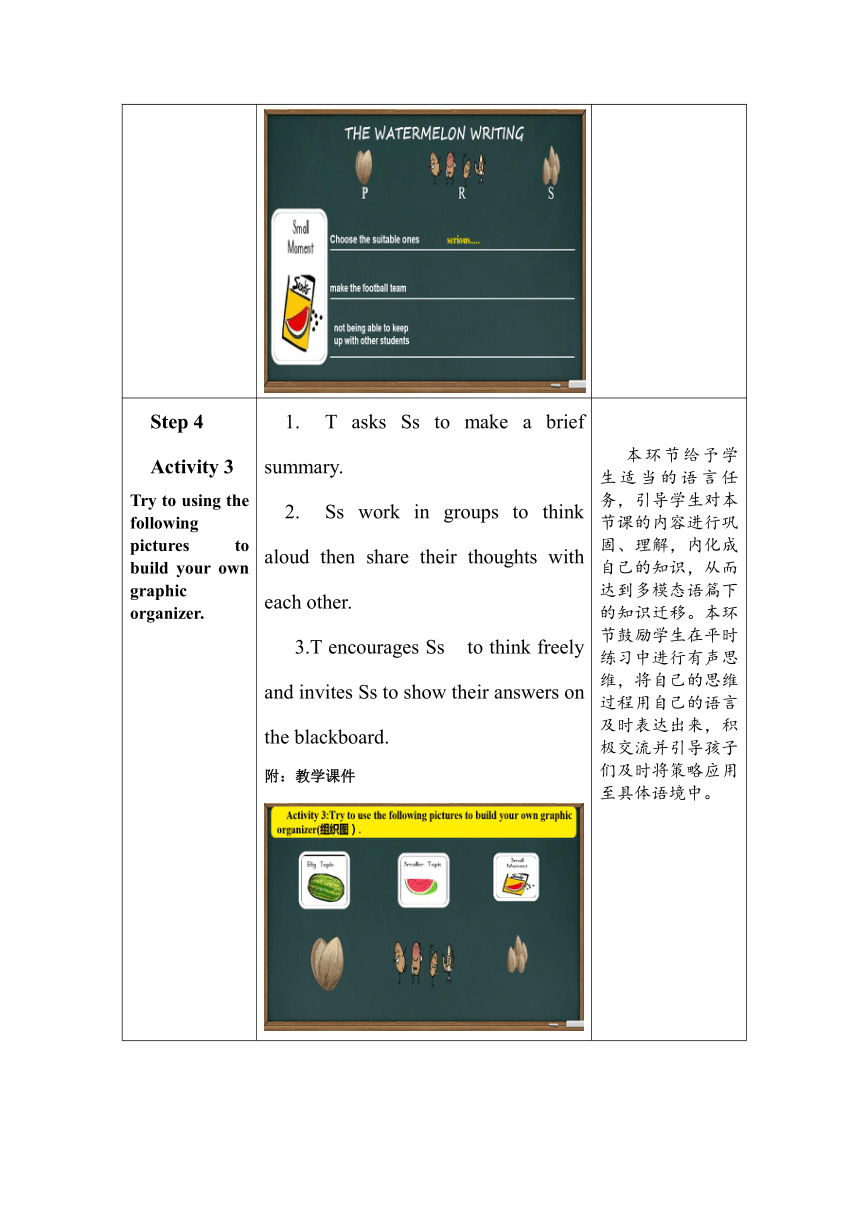人教版(2019) 必修第一册Unit 1 Teenage Life Reading and Thinking 教学设计(表格式)
文档属性
| 名称 | 人教版(2019) 必修第一册Unit 1 Teenage Life Reading and Thinking 教学设计(表格式) |  | |
| 格式 | docx | ||
| 文件大小 | 4.1MB | ||
| 资源类型 | 教案 | ||
| 版本资源 | 人教版(2019) | ||
| 科目 | 英语 | ||
| 更新时间 | 2025-02-06 23:56:00 | ||
图片预览




文档简介
Book 1 Unit1 Teenage Life
Content: Reading and thinking --The Freshman Challenge
Teaching Objectives
By the end of this class,students will be able to:
1.learn about teenage problems and solutions.
2. learn something about text organization.
3. be involved in team cooperation actively.
4. re-examine their study and life in senior high school,then form a positive attitude to face more challenges.
Teaching important and difficult points
Learn something about text organization and make some text connections.
Teaching methods
Individual, pair or group work.
Question-and-answer activity
.Teaching Process
教学步骤 教学活动 教学意图
Step 1 Lead-in T introduces the topic of this class and asks Ss to do “homework-sharing” first. Then T asks other students to talk about how they feel . 以“Homework Sharing”环节导入,通过演讲形式,鼓励学生畅所欲言,谈论自己正在亲身经历的高中生活,从而导入本话题。
Step 2 Activity 1 Read the lines and perceive the text organization. T asks students to read the lines first. T asks Ss to find the big topic and smaller topics to perceive the text organization better . Then T asks Ss to guess how the author will develop these smaller topics. Ss share and explain their opinions. 附:教学课件 本环节开始前,教师将本文本的结构组织形式比喻为“watermelon writing”。假如watermelon被比作文本的big topic,那么watermelon pieces就是smaller topics。活动一就是要求学生们通过read the lines,梳理文本主题,感知文本组织形式。任务完成后,教师引导学生及时进行反思,比如 how do you think the author will develop these topics?以问答的方式激起学生的好奇心与求知欲。
Step 3 Activity 2 Read between the lines and find out some supporting details. 1.T asks students to read between the lines. 2.T invites Ss to think about some questions about topic development. 3. T leads Ss to find more supporting details, then gives some some strategies about reading and writing . 附:教学课件 假如smaller topics是watermelon pieces,那么西瓜籽就是里面的smaller moments。具体的段落组织形式,我们把它看作剥瓜子的过程。假如瓜子就是problems,那么瓜子仁就是solutions. 中间瓜子皮的反应就是response.即文本的组织形式为P-R-S。 以本文第二段为例,示范引导,让学生在自己熟悉的语境中感知语篇组织形式,使文本理解更具条理性。通过形象生动的比喻,将抽象的文本组织概念形象化,加深学生的记忆。 教师借此机会,给予适当的阅读和写作策略清单.引导学生感知文本的组织形式,步步深入,从而促使学生能够在具体语境中灵活使用该策略。
Step 4 Activity 3 Try to using the following pictures to build your own graphic organizer. T asks Ss to make a brief summary. Ss work in groups to think aloud then share their thoughts with each other. 3.T encourages Ss to think freely and invites Ss to show their answers on the blackboard. 附:教学课件 本环节给予学生适当的语言任务,引导学生对本节课的内容进行巩固、理解,内化成自己的知识,从而达到多模态语篇下的知识迁移。本环节鼓励学生在平时练习中进行有声思维,将自己的思维过程用自己的语言及时表达出来,积极交流并引导孩子们及时将策略应用至具体语境中。
Step 5 Activity 4 Read beyond the lines and make text connections. T asks Ss to read beyond the lines and make text connections. .Text-to-Text It reminds me of a text. .Text-to-Self It reminds me of my own life. .Text-to-world It reminds me of something in the world around me. 附:教学课件 本环节要求学生在文本组织形式熟悉的基础上进一步阅读,通过making connections, 从text-to-text,text-to-self,和text-to-world三个角度,让学生体悟作者在文章中传达出来的情感和情绪,感知文章的“温度”,与作者互动,发生情感共鸣。
Step 6 Activity 5: Self-evaluation SUMMARY OF STUDENTS’ PERFORMANCE Name: Date: Total scores:100 Informal Reading Inventory Text organization(40%) Text comprehension(20%) Text connections(40%)
任务完成后,鼓励学生进行自我评价,深度思考语篇结构背后的语言价值,促进语言运用的自动化,助力学生对自身的学习进行反思和思考。
Step 7 Summary&Homework T invites Ss to summarize what they have learned. Assignments Try to use “the watermelon writing method” to write your challenges of your senior high life. 设置写作作业,让学生在写作中感悟文本组织形式,同时,结合本阅读话题,让学生对相同话题表达自己的见解与想法。
Blackboard design:
Topic: The Freshman Challenge
Content: Reading and thinking --The Freshman Challenge
Teaching Objectives
By the end of this class,students will be able to:
1.learn about teenage problems and solutions.
2. learn something about text organization.
3. be involved in team cooperation actively.
4. re-examine their study and life in senior high school,then form a positive attitude to face more challenges.
Teaching important and difficult points
Learn something about text organization and make some text connections.
Teaching methods
Individual, pair or group work.
Question-and-answer activity
.Teaching Process
教学步骤 教学活动 教学意图
Step 1 Lead-in T introduces the topic of this class and asks Ss to do “homework-sharing” first. Then T asks other students to talk about how they feel . 以“Homework Sharing”环节导入,通过演讲形式,鼓励学生畅所欲言,谈论自己正在亲身经历的高中生活,从而导入本话题。
Step 2 Activity 1 Read the lines and perceive the text organization. T asks students to read the lines first. T asks Ss to find the big topic and smaller topics to perceive the text organization better . Then T asks Ss to guess how the author will develop these smaller topics. Ss share and explain their opinions. 附:教学课件 本环节开始前,教师将本文本的结构组织形式比喻为“watermelon writing”。假如watermelon被比作文本的big topic,那么watermelon pieces就是smaller topics。活动一就是要求学生们通过read the lines,梳理文本主题,感知文本组织形式。任务完成后,教师引导学生及时进行反思,比如 how do you think the author will develop these topics?以问答的方式激起学生的好奇心与求知欲。
Step 3 Activity 2 Read between the lines and find out some supporting details. 1.T asks students to read between the lines. 2.T invites Ss to think about some questions about topic development. 3. T leads Ss to find more supporting details, then gives some some strategies about reading and writing . 附:教学课件 假如smaller topics是watermelon pieces,那么西瓜籽就是里面的smaller moments。具体的段落组织形式,我们把它看作剥瓜子的过程。假如瓜子就是problems,那么瓜子仁就是solutions. 中间瓜子皮的反应就是response.即文本的组织形式为P-R-S。 以本文第二段为例,示范引导,让学生在自己熟悉的语境中感知语篇组织形式,使文本理解更具条理性。通过形象生动的比喻,将抽象的文本组织概念形象化,加深学生的记忆。 教师借此机会,给予适当的阅读和写作策略清单.引导学生感知文本的组织形式,步步深入,从而促使学生能够在具体语境中灵活使用该策略。
Step 4 Activity 3 Try to using the following pictures to build your own graphic organizer. T asks Ss to make a brief summary. Ss work in groups to think aloud then share their thoughts with each other. 3.T encourages Ss to think freely and invites Ss to show their answers on the blackboard. 附:教学课件 本环节给予学生适当的语言任务,引导学生对本节课的内容进行巩固、理解,内化成自己的知识,从而达到多模态语篇下的知识迁移。本环节鼓励学生在平时练习中进行有声思维,将自己的思维过程用自己的语言及时表达出来,积极交流并引导孩子们及时将策略应用至具体语境中。
Step 5 Activity 4 Read beyond the lines and make text connections. T asks Ss to read beyond the lines and make text connections. .Text-to-Text It reminds me of a text. .Text-to-Self It reminds me of my own life. .Text-to-world It reminds me of something in the world around me. 附:教学课件 本环节要求学生在文本组织形式熟悉的基础上进一步阅读,通过making connections, 从text-to-text,text-to-self,和text-to-world三个角度,让学生体悟作者在文章中传达出来的情感和情绪,感知文章的“温度”,与作者互动,发生情感共鸣。
Step 6 Activity 5: Self-evaluation SUMMARY OF STUDENTS’ PERFORMANCE Name: Date: Total scores:100 Informal Reading Inventory Text organization(40%) Text comprehension(20%) Text connections(40%)
任务完成后,鼓励学生进行自我评价,深度思考语篇结构背后的语言价值,促进语言运用的自动化,助力学生对自身的学习进行反思和思考。
Step 7 Summary&Homework T invites Ss to summarize what they have learned. Assignments Try to use “the watermelon writing method” to write your challenges of your senior high life. 设置写作作业,让学生在写作中感悟文本组织形式,同时,结合本阅读话题,让学生对相同话题表达自己的见解与想法。
Blackboard design:
Topic: The Freshman Challenge
